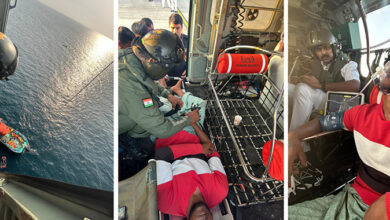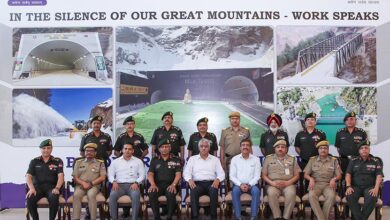CRPF An Omnipotent Force

THE CENTRAL Reserve Police Force (CRPF) is the successor of Crown Representative’s Police works under the Ministry of Home Affairs, and came into existence with the present nomenclature in December 1949. It has a multifaceted role and provides assistance to state police in the maintenance of law and order; controls counter-insurgency, involved in the safe and secure conduct of general elections which is a gargantuan task in India. CRPF units are also deployed on peace mission duties under the aegis of United Nations.
CRPF is used in multifarious emergency situations. In September 2009, when a Bell 430 helicopter carrying the then Andhra Pradesh Chief Minister YS Rajasekhara Reddy crashed and could not be traced, more than 5,000 CRPF personnel were deployed to successfully search the wreckage of the helicopter.
CRPF, which has emerged as the biggest paramilitary force in the country, consists of 235 battalions including 10 Commando Battalions for Resolute Action (CoBRA) and five Mahila Battalions. It has 42 Group Centres, 20 Training Institutes, and 21 Hospitals. The Training Institutes impart trainings on physical fitness, internal security, counter-insurgency, anti-terrorism, management of improvised explosive devices (IEDs) etc.
The force over the years has been successful both in facing foreign invasions as well as handling domestic unrest. Notably, CRPF was also guarding India-Pakistan Border till 1965 before the creation of Border Security Force.
In 1992, 10 battalions were carved out from CRPF and the Rapid Action Force was created basically to handle civil unrest especially communal riots.
On December 13, 2001 when heavily armed five Pakistani terrorists of Lashkar-e-Taiba (L-e-T) and Jaish-e-Mohammed attacked Indian Parliament, the valiant CRPF men along with other security agencies killed all Pakistan trained terrorists before they could enter the main hall of Parliament where the then Home Minister and several other important politicians were present.
In view of expertise achieved by CRPF when Parliament Duty Group (PDG) was constituted, all personnel of PDG were taken from CRPF and were imparted commando training, handling natural calamities, countering nuclear and bio-chemical emergencies and were especially trained in rescue operations. PDG was tasked to safeguard Parliament House Complex and was equipped with latest weapons and communication equipment.
COUNTERING THE LEFT WING EXTREMISM
The CRPF is a multi-task force in the real sense and can be deployed anywhere in the country to deal with emergent situations, nonetheless the force has achieved laurels in handling the Left Wing Extremism (LWE). The gravity of LWE problem can be judged by the fact that in 2008 the then Prime Minister Manmohan Singh stated that Naxalism was the greatest threat to country’s internal security. Large number of CRPF personnel have lost their lives encountering terrorist attacks.
According to reports, in 2007 LWE had influence in more than 180 districts of the country and were controlling more than 92,000 square kilometers of area but after the concerted efforts of CRPF and other security agencies, the LWE lost ground and in 2011 the influence was reduced to 83 districts, and now it is further reduced.
In 2008, especially trained personnel of CRPF in guerilla warfare were taken into Commando Battalion for Resolute Action (CoBRA) to encounter mounting menace of LWE. All the 10 units of CoBRA were especially trained in counter-terrorism and sabotage, handling of modern weapons and latest communication devices so that they trail and exterminate diverse groups of LWE.
In view of sensitivity of LWE operations, CRPF units were also given Unmanned Aerial Vehicles (UAVs), satellite phones etc. However, the UAVs were not very successful because LWE cadres were hiding in dense forests. Hence Defence Research and Development Organisation (DRDO) developed UAVs with “lower frequency radars†which would enable detection of LWE cadres. Government has also imported 10 drones with appropriate sensors from Israel to locate Naxalites in thick forests.
According to conservative estimates, more than 13,000 persons including civilians, security force personnel and Naxalites have lost their lives in the last 20 years. However, the figures indicate that in 2015 the deaths were considerably reduced and more terrorists were killed than civilians and personnel of security forces. Security forces were able to arrest more Naxalites and the number of surrendered LWE cadres also swelled. This resulted in the incidents of violence perpetrated by LWE cadres getting dwindled. The influence of Naxalites has diminishing due to the well equipped and well trained CRPF successfully attacking their hideouts.
Not only this, CRPF has launched several public welfare programmes including distribution of radios, mosquito nets, polythene sheets, indoor and outdoor games, books and magazines. CRPF also provided medical facilities in LWE affected areas. The CRPF was able to win hearts of residents of LWE areas through these public relation exercises.
The Naxalites extort more than 14 billion rupees annually from the areas under their control and when they feel that their control is declining, they attack security forces to demonstrate their strength and also kill innocent citizens alleging them as spies just to retain their awe over the local populace. Several times innocent locals were exterminated by Naxalites when they refused to abide by their dictates. Few teachers, Gram Pradhans were also murdered was they raised voices against the exploitation of LWE and highlighted to the public that Naxalites are against the development of the area hence they should not cooperate with them.
The nefarious Inter Services Intelligence (ISI) is also assisting LWE through various terrorist outfits especially Indian Mujahedeen (IM) and Lashkar-e-Taiba (L-e-T). The military controlled ISI provides arms, ammunition and requisite training to Naxalites. LWE has also overt and covert support from “five star human rights activistsâ€, various NGOs financed by foreign powers and also by few misguided intellectuals who genuinely feel that LWE is fighting for the rights of deprived and underprivileged people. The CRPF has to tackle these groups very carefully as they are always ready to demonstrate against security forces but choose to remain silent when Naxalites kill the security forces’ personnel.
The LWE problem is not only a law and order problem, the Naxal affected areas are under-developed and lack even the basic facilities. There are no roads, rail or employment opportunities; there are no schools or colleges. The CRPF is providing some facilities under public relations programmes but it is not adequate. Both Central and State Governments need to launch programmes of poverty eradication, employment opportunities should be created, educational institutions should be opened and communication network must be established.
In fact, once the security agencies clear the area from the control of LWE then the development work should start in the region to end the LWE influence. Government and security forces must highlight the good work done by them to win the public support.
THE WAY FORWARD
This prestigious force was earlier lacking in the intelligence training of personnel which is very important to perform its role. So far, CRPF was dependent on intelligence from local police, Intelligence Bureau and other intelligence organisations. Several times the force was receiving stale information or the information was so general that it was not feasible to some services including Yoga and meditation classes should be made compulsory to mitigate stress level. In short, more facilities should be given to CRPF personnel so that the attrition rate is reduced and the force does not loose trained personnel take action on it.
Now a full -fledged intelligence training school has started functioning in CRPF Academy where directly recruited Assistant Commandants are trained in collection of intelligence and other tradecraft subjects in capsule courses while Commandants and other officers are trained in refresher courses.
Intelligence training is also imparted to subordinate staff. The trade craft subjects are taught by trained and competent CRPF officers as well as by officers of other intelligence organisations. It is a laudable effort because the CRPF units work in terrorist affected areas and if they collect actionable intelligence it can further facilitate eradication of LWE.
The working conditions of CRPF need drastic changes as the existing facilities in the field areas are totally inadequate. In field areas there is lack of appropriate accommodation, sanitation, mobile connectivity and proper logistics, no weekly holidays, long and tiring working hours, repeated and erratic transfers and difficult to get annual leave when it is required, separation from family, all these difficulties increase the attrition rate in CRPF.
In 2013, more than 4,000 CRPF personnel left the force while the number swelled to 6,700 in 2014.
The number of suicides, premature retirements and desertions are increasing rapidly due to stress and insufficient facilities. The force increased manifold but the infrastructure has not kept pace accordingly. In LWE areas more CRPF personnel die because of Malaria and heart attacks than in encounters.
In view of the hardships faced by the CRPF personnel, it is the foremost duty of the nation to provide them good infrastructure, basic amenities, proper rest and annual leave. They must get hardship allowance and pay scale commensurate to their tough and risky life. The pay, allowances and facilities must compensate the extra expenditure CRPF personnel incur due to the separation from their families.
In view of high casualty rate, the government should provide compassionate appointments to family members and death-cum-retirement gratuity needs to be increased . Children Education Allowance should be augmented and more quotas should be fixed in professional institutions to the wards of CRPF personnel.
The retirement age should be increased to 60 years as longevity of life and health conditions have considerably improved. One rank one pension should also be enforced. Yoga and meditation classes should be made compulsory to mitigate stress level. In short, more facilities should be given to CRPF personnel so that the attrition rate is reduced and the force does not loose trained personnel.
– Jai Kumar Verma is a Delhi-based security analyst





